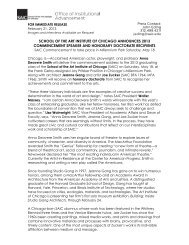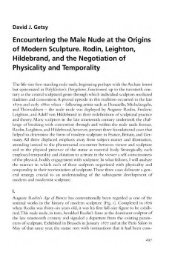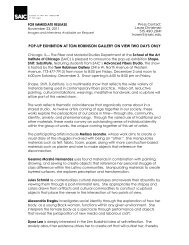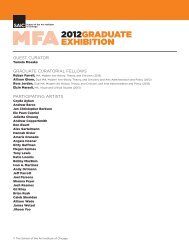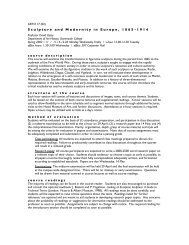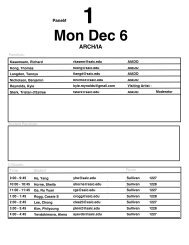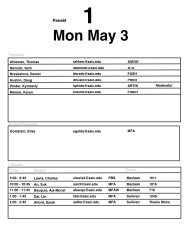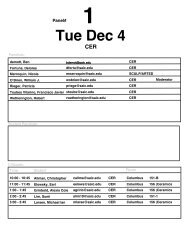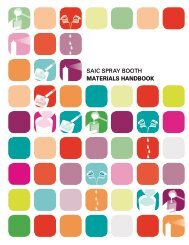i. institutional support and commitment to continuous improvement
i. institutional support and commitment to continuous improvement
i. institutional support and commitment to continuous improvement
Create successful ePaper yourself
Turn your PDF publications into a flip-book with our unique Google optimized e-Paper software.
School of the Art Institute of Chicago<br />
Department of Architecture, Interior Architecture, <strong>and</strong> Designed Objects<br />
Master of Architecture<br />
Master of Architecture with emphasis in Interior Architecture<br />
Course Number & Title:<br />
ARCH 6210 Architecture Studio 5: Integrations (4.5)<br />
Course Description:<br />
This comprehensive design studio examines how<br />
creative program analysis drives creative, complex<br />
design solutions. This studio uses innovative program-<br />
ming techniques <strong>to</strong> design large-scale buildings <strong>and</strong><br />
complexes. The final projects integrate design ideas<br />
with structures <strong>and</strong> systems. The course uses a vari-<br />
ety of discrete analytical, diagrammatic <strong>and</strong> visualiza-<br />
tion exercises <strong>to</strong> register obscure existing conditions<br />
<strong>and</strong> cultural changes in<strong>to</strong> clear terms so the designer,<br />
client <strong>and</strong> the public can underst<strong>and</strong> them <strong>and</strong> the<br />
new solutions that arise out of them.<br />
Course Goals & Objectives:<br />
1) Design culture: methods of integration <strong>and</strong><br />
information synthesis in contemporary architectural<br />
design.<br />
2) Design practice: advanced design methods, em-<br />
phasizing feasibility, <strong>and</strong> comprehension through<br />
the design of a large building with an extensive<br />
systems integration challenge.<br />
3) Design techniques <strong>and</strong> skills: develop an ad-<br />
vanced level of architectural representation, with an<br />
emphasis on analysis, plans, sections <strong>and</strong> eleva-<br />
tions, <strong>and</strong> model construction.<br />
Student Performance Criterion:<br />
1) Best exemplifies the following criteria:<br />
a) B.6. Comprehensive Design (ability)<br />
b) B.7. Financial Considerations (underst<strong>and</strong>ing)<br />
2) Additional criteria associated with SPC B.6<br />
a) A.2. Design Thinking (ability)<br />
b) A.4 Technical Documentation (ability)<br />
c) A.5. Investigative Skills (ability)<br />
d) A.8. Ordering Systems Skills (underst<strong>and</strong>ing)<br />
e) A.9 His<strong>to</strong>rical Traditions & Global Culture<br />
(underst<strong>and</strong>ing)<br />
f) B.2. Accessibility (ability)<br />
g) B.3. Sustainability (ability)<br />
h) B.4. Site Design (ability)<br />
i) B.5. Life Safety (ability)<br />
j) B.8. Environmental Systems (underst<strong>and</strong>ing)<br />
k) B.9. Structural Systems (underst<strong>and</strong>ing)<br />
l) B.11. Building Service Systems (underst<strong>and</strong>ing)<br />
Topical Outline:<br />
1) Design culture: ‘disciplinary literacy’— student<br />
will examine <strong>and</strong> critique contemporary practice<br />
Architecture Program Report | 178<br />
relevant <strong>to</strong> studio <strong>to</strong>pic; 10% of the course.<br />
2) Design practice: through a series of lectures <strong>and</strong><br />
exercises, students will be introduced <strong>to</strong> informa-<br />
tion collection <strong>and</strong> research methodologies; stu-<br />
dents will prepare a series of explana<strong>to</strong>ry graphics<br />
describing proposed programmatic conditions in<br />
existing behavioral contexts, system integrations<br />
<strong>and</strong> comprehensive planning; 15% of the course.<br />
3) Design practice: working from ideas generated<br />
through the case studies, site analysis <strong>and</strong> systems<br />
research, students will develop a design for a large<br />
urban building that integrates site considerations<br />
with architectural ideas; students will work through<br />
an iterative process that integrates analog <strong>and</strong><br />
digital techniques, <strong>and</strong> will make formal presenta-<br />
tions at 50%, 75% <strong>and</strong> 100% completion, 15% of the<br />
course.<br />
4) Design techniques: students will document their<br />
design through a complete <strong>and</strong> coordinated set of<br />
design research diagrams, tables <strong>and</strong> reports, site<br />
plans <strong>and</strong> sections, building plans, sections, eleva-<br />
tions, showing context, <strong>and</strong> materials, using CAD,<br />
<strong>and</strong> showing appropriate symbology <strong>and</strong> notations<br />
at a professional level; 25% of the course.<br />
5) Design techniques: students will document<br />
their conceptual design through physical site <strong>and</strong><br />
building models, emphasizing material effects <strong>and</strong><br />
formal ideas, at a professional level; 25% of the<br />
course.<br />
6) Design techniques: students will complete ap-<br />
proximately 10’x10’ <strong>to</strong>tal of presentation boards,<br />
showing all plans, sections <strong>and</strong> elevation context,<br />
<strong>and</strong> materials, along with <strong>support</strong>ing analysis <strong>and</strong><br />
information, that may include vignettes <strong>and</strong> mod-<br />
els, at a professional level; 25% of the course.<br />
Prerequisites:<br />
All required fourth semester coursework.<br />
Textbooks/Learning Resources:<br />
Various sources including: S,M,L,XL by Rem Kool-<br />
haas <strong>and</strong> Bruce Mau<br />
Offered (semester <strong>and</strong> year):<br />
• Semester: FALL<br />
• Year: THREE<br />
Faculty assigned:<br />
• 2009-2010 academic year:<br />
Ahleman, Thomas (P/T), Tornheim, Dan (P/T)<br />
• 2010-2011 academic year:<br />
Ahleman, Thomas (P/T), Exley, Peter (P/T)



